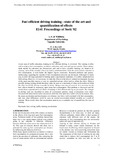JavaScript is disabled for your browser. Some features of this site may not work without it.
| dc.contributor.author | af Wåhlberg, Anders E. | |
| dc.date.accessioned | 2018-01-12T10:29:23Z | |
| dc.date.available | 2018-01-12T10:29:23Z | |
| dc.date.issued | 2002-10-23 | |
| dc.identifier.citation | af Wåhlberg AE, Fuel efficient driving training - state of the art and quantification of effects. Proceedings of the 2nd Safety on Road International Conference 2002, 21-23 October 2002, University of Bahrain, Bahrain, Paper number E141 | en_UK |
| dc.identifier.uri | https://dspace.lib.cranfield.ac.uk/handle/1826/12886 | |
| dc.description.abstract | A new area of traffic education, training in fuel efficient driving, is reviewed. This training is often said to reduce fuel consumption, accidents, emissions, and wear and tear on vehicles. These claims, made mainly by educators and bureaucrats, and said to have scientific backing, are found to be wanting; most of the possible effects are totally unsubstantiated, while the most central, reduction in fuel consumption, is well below the highest figures mentioned. Research problems and general methodology regarding the variable of fuel consumption reduction are discussed. Although it is fairly easy to show the large potential of training under experimental conditions, it is rather complicated in a field setting. However, it is necessary to study the effects in the drivers' natural environment, because of the many possible sources of error in controlled settings which tend to inflate the effect. What is possible during training should therefore rather be seen as a maximum of what can be achieved, while the effect in real life driving is usually far below. Being a new area of research, it is uncertain exactly how effects should be measured, apart from fuel consumption. This problem is discussed and the results from a quantification of effects of training in fuel efficient driving are presented. The changes in driving style are described in terms of acceleration patterns; mean accelerations (over time) increased and mean decelerations decreased, while the time spent on a stable velocity decreased. Also, the mean acceleration and deceleration over distance was fairly well correlated with fuel consumption, and very clear differences could be seen on several acceleration-related variables as a result of training. These results show that acceleration patterns are a workable way of quantifying this type of training. | en_UK |
| dc.language.iso | en | en_UK |
| dc.rights | © The Authors. This is the Author Accepted Manuscript. | |
| dc.subject | Fuel | en_UK |
| dc.subject | Driving | en_UK |
| dc.subject | Traffic | en_UK |
| dc.subject | Training | en_UK |
| dc.subject | Acceleration | en_UK |
| dc.title | Fuel efficient driving training - state of the art and quantification of effects | en_UK |
| dc.type | Conference paper | en_UK |
Files in this item
This item appears in the following Collection(s)
-
Staff publications (SATM) [4358]
